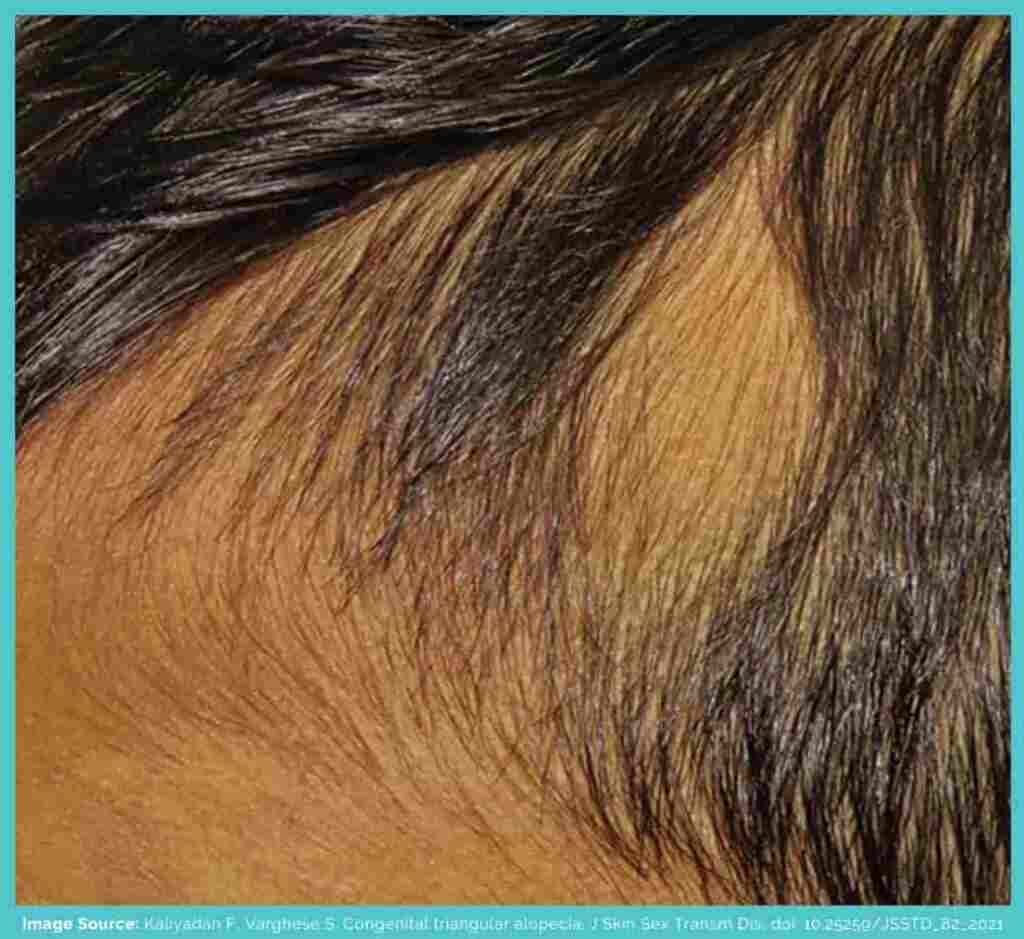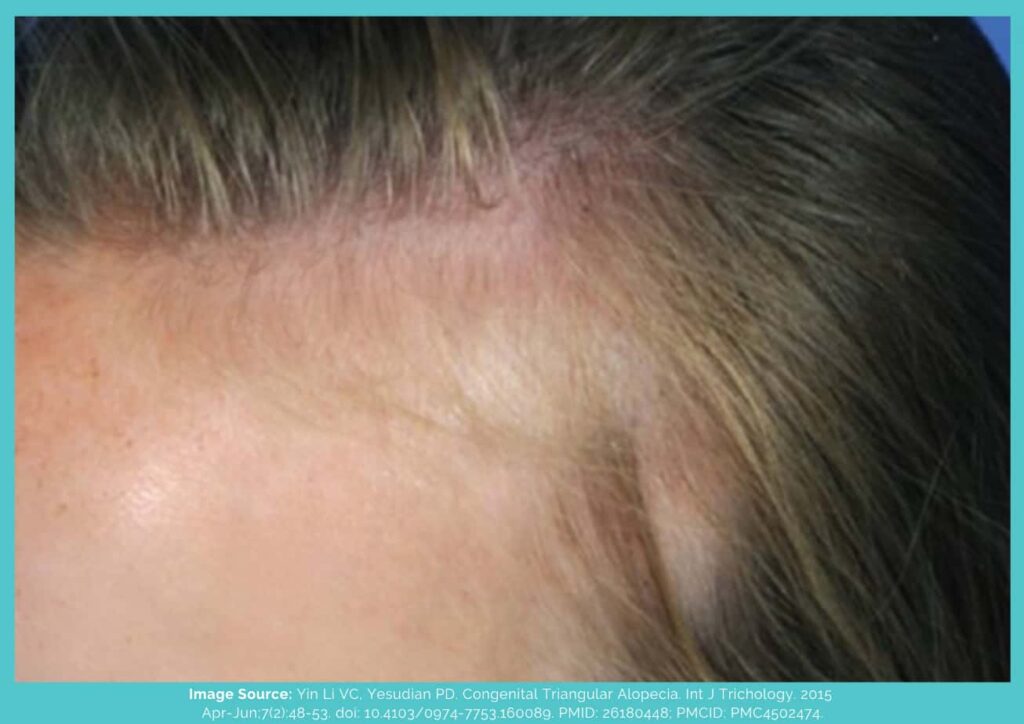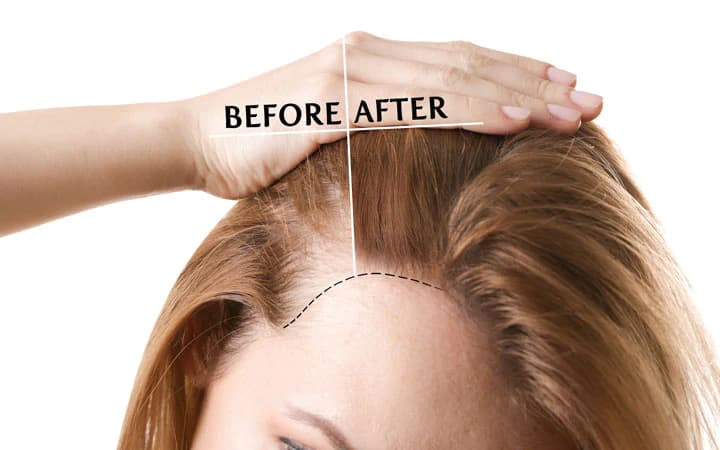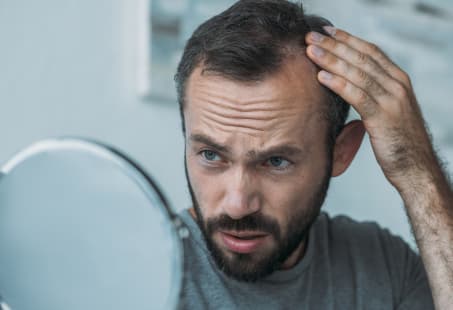Triangular alopecia, also known as congenital or temporal triangular alopecia, is a type of pattern of hair loss usually affecting the front of the scalp.
Because of how it looks, it can be quite easily confused with other types of alopecia, such as androgenetic alopecia, traction alopecia, alopecia areata, trichotillomania, or even cicatricial (scarring) alopecia. This is, however, a distinctive kind of hair loss.
It’s not accompanied by any symptoms, and unlike pattern baldness, it’s not progressive. So the triangular patch will stay in place for the rest of your life.
Although fortunately, there are things that you can do to get rid of this. In this guide, you’ll learn more about that and the underlying cause of this condition.
What Is A Triangular Alopecia?
Triangular alopecia, as the name suggests, is a type of patterned hair loss that leaves a non-scarring triangular bald spot on the scalp. But it’s not always strictly a triangle; it can also be somewhat circular or oval or lance-shaped (like the leaf tapering to a pointed apex).


It’s considered a benign lesion on the scalp that is quite often misdiagnosed or mistaken for something else.
One study published in Pediatric Dermatology found that it had an incidence of 0.11%, but many researchers take issue with this number because of how triangular alopecia has historically been diagnosed. It’s believed to be more common yet widely underreported.
Parents don’t always realise that their children might be born with this condition. Because hair loss in newborns is quite common yet temporary, it’s possible that they try to wait out the bald spot. However, usually, parents end up seeking help after the child turns 2.
Here, it should also be noted that while the bald spot usually appears in the front and temporal regions of the scalp, sometimes, it can also be seen between the temple and crown area or the back of the head.
But when it’s at the front, it can sometimes be hard to distinguish it from the temple peaks of a receding hairline. However, it’s more clearly demarcated when there’s a small fringe of hair around it.
The size of this bald patch is usually around 3-5 cm in size and can be covered by fine vellus hair instead of being entirely bald. It doesn’t always occur in one area on the scalp, less commonly, it can also be “bilateral,” affecting both sides of the scalp.
Another interesting thing about congenital triangular alopecia is that it’s been reported to occur in association with certain health problems, such as:
- Down syndrome
- Woolly hair
- Dandy-Walker malformation
- Leukonychia
- Phakomatosis pigmentovascularis
What Are The Symptoms & Signs Of Triangular Alopecia?
Temporal triangular alopecia is a benign asymptomatic lesion on the scalp.
However, according to a study published in Anais Brasileiros de Dermatologia, some patients with this condition report “dysesthesia,” which refers to an abnormal sensation on touching the skin.
As far as the signs of congenital triangular alopecia are concerned, one thing that usually distinguishes it from other types of alopecia is the presence of miniaturised hair follicles. It refers to the constricting of the hair follicles.
As a result, the hair growing out of it becomes thinner and thinner, leading to eventual baldness.
As mentioned above, you can find thin and fine vellus hair within such bald patches (although not always).
And while the same happens in pattern baldness or androgenetic alopecia as well, what makes it different is that it doesn’t progress. The size of the triangular patch remains the same, and no new hair regrows in it.
Is Temporal Triangular Alopecia Permanent?
Temporal triangular alopecia is permanent. It doesn’t go into remission, resolves on its own and starts growing hair once you enter adulthood.
This lesion will remain as is. However, your doctor might try to improve growth in the area by prescribing different medications. If that doesn’t work, surgery’s another option.
Does Triangular Alopecia Spread?
One of the unique features of triangular alopecia is that it doesn’t spread. It will retain its original dimensions as you grow older.
So you don’t have to worry about it progressing and engulfing other areas of your scalp. It doesn’t get worse.
What Causes Triangular Alopecia?
It’s not known what causes triangular alopecia. However, since it can be a congenital condition – being present from birth – and can be found in families, it’s believed to have a genetic component.
But it should be noted that this isn’t always the case. Triangular alopecia has been reported in individuals who have no family history of this type of hair loss.
How Do You Fix Triangular Alopecia?
Minoxidil might be prescribed to improve hair growth in the area affected by temporal triangular alopecia.
A care report published in the International Journal of Trichology described a patient who grew new vellus hair in their bald spot after 3 months of applying topical minoxidil.
However, there’s no guarantee that a treatment is going to work. In fact, it’s generally considered unnecessary and ineffective.
Although if medication isn’t working, your surgeon might also advise you to take a surgical route. It can involve:
- Cutting out the piece of skin from the scalp or
- Transplanting new hair into the bald spots
You might be familiar with the first option as a scalp reduction or alopecia reduction surgery. In this procedure, once the affected skin is excised, the hair-bearing areas are pulled over it to cover it.
The second option is that of a traditional hair transplant surgery. This surgery can also effectively hide your bald spot by simply taking healthy hair from other areas of the scalp and implanting them into the triangular spot(s).

Conclusion
Not many people are aware of triangular alopecia. In fact, because of how it looks, it can be very easily confused with more common and popular hair loss types like androgenetic alopecia or traction alopecia. In truth, however, it’s something completely different.
Unlike other alopecias, this hair loss remains confined in one place. It remains unchanged, but it may not be completely without hair. Regardless, depending on the size of the bald spot and where it’s located, you may feel distressed about its appearance (or mere presence).
While you might be tempted to try self-medication to resolve this issue, you must keep in mind that this type of hair loss can also happen due to other reasons. For this reason, you must first consult a medical professional for an accurate diagnosis and treatment plan.
Reviewed and Approved by Trichologist Yaprak Yazan


